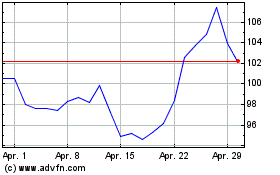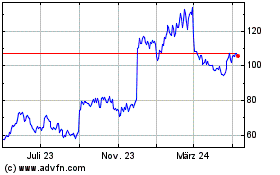Elastic Introduces Native Microsoft Azure Integration, Fleet Server, and Enhanced APM Workflows in Elastic Observability
26 Mai 2021 - 5:47PM
Business Wire
Streamlining Workflows in Microsoft Azure,
Simplifying Data Integrations, and Accelerating Root Cause
Analysis
- Adding support for Microsoft Azure monitoring use cases with
native Microsoft Azure console integration
- Enabling additional scalability and flexibility of data ingest
architectures with the beta release of Fleet Server
- Accelerating root-cause analysis and lowering
mean-time-to-resolution (MTTR) with time comparison and enhanced
APM service instance views
Elastic (NYSE: ESTC) (“Elastic”), the company behind
Elasticsearch and the Elastic Stack, announces new features and
updates across the Elastic Observability solution in its 7.13
release to streamline workflows in Microsoft Azure, simplify data
integrations, and accelerate root cause analysis. Expanded
capabilities include native integration in the Microsoft Azure
console, the beta release of Fleet Server, and new troubleshooting
views in Elastic APM.
Elastic is announcing an enhanced partnership with Microsoft,
enabling users to find and deploy Elastic directly from the Azure
console and natively integrate observability and security data from
Azure services. In Elastic Observability, the new native Azure
console integration allows customers to easily onboard logs and
metrics from their Azure services. This includes both compute
services, such as virtual machines and containers, and non-compute
services, such as Azure SQL Database and Azure Data Factory. Users
can easily configure their setups with tag-based filters to limit
data collection to only specific resources.
Elastic also announces the beta release of Fleet Server, a new
app in Kibana that allows practitioners to centrally manage an
entire fleet of Elastic Agents. Fleet Server offers a distributed
architecture for scalability and flexible deployment. It can be
deployed either centrally or close to Elastic Agents. Together, the
Azure console integration and Fleet Server significantly lower
total cost of ownership and time to value for users of Elastic
Observability.
New enhancements to the Elastic APM Service Overview page are
now available with time comparison and enhanced APM service
instance views, enabling users to further accelerate root cause
analysis and lower mean-time-to-resolution (MTTR). The time
comparison view allows users to quickly and directly compare
current and historical behavior, while the scatterplot view
displays instances by latency and load distribution to reveal
instances that are behaving differently under load. An enhanced
instance panel breaks down services by instance, providing
per-instance metrics and trends to quickly identify which instances
might be contributing to service issues.
For more information read the Elastic blog about what’s new in
Elastic Observability 7.13.
About Elastic:
Elastic is a search company built on a free and open heritage.
Anyone can use Elastic products and solutions to get started
quickly and frictionlessly. Elastic offers three solutions for
enterprise search, observability, and security, built on one
technology stack that can be deployed anywhere. From finding
documents to monitoring infrastructure to hunting for threats,
Elastic makes data usable in real time and at scale. Thousands of
organizations worldwide, including Cisco, eBay, Goldman Sachs,
Microsoft, The Mayo Clinic, NASA, The New York Times, Wikipedia,
and Verizon, use Elastic to power mission-critical systems. Founded
in 2012, Elastic is a distributed company with Elasticians around
the globe and is publicly traded on the NYSE under the symbol ESTC.
Learn more at elastic.co.
The release and timing of any features or functionality
described in this document remain at Elastic’s sole discretion. Any
features or functionality not currently available may not be
delivered on time or at all.
Elastic and associated marks are trademarks or registered
trademarks of Elastic N.V. and its subsidiaries. All other company
and product names may be trademarks of their respective owners.
View source
version on businesswire.com: https://www.businesswire.com/news/home/20210526005871/en/
Chloe Guillemot Elastic Public Relations PR-Team@elastic.co
Elastic NV (NYSE:ESTC)
Historical Stock Chart
Von Mär 2024 bis Apr 2024

Elastic NV (NYSE:ESTC)
Historical Stock Chart
Von Apr 2023 bis Apr 2024
